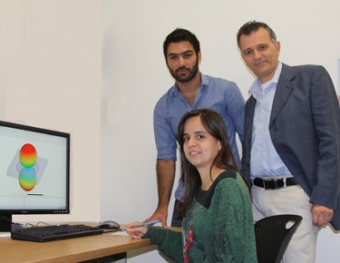 Design. Test. Adapt. Repeat. For many years, trial and error guided product development. Engineers designed on paper, built a prototype, tested it in the lab, and made changes based on test results. They repeated the process an untold number of times, until the product met specifications. It was costly and time-consuming.
Design. Test. Adapt. Repeat. For many years, trial and error guided product development. Engineers designed on paper, built a prototype, tested it in the lab, and made changes based on test results. They repeated the process an untold number of times, until the product met specifications. It was costly and time-consuming.
Today, engineers design and test products on their computers with CAD (computer-aided design) and simulation software. And now, thanks to a generous donation from software company ANSYS, Inc., a new generation of UC Irvine students has the opportunity to use the software simulation tools, making them ready and able to compete for jobs after graduation.
ANSYS has donated more than 500 licenses that cover both electrical and mechanical engineering software packages, as well as multi-physics (multidisciplinary) simulations. The donation also includes High Performance Computing (HPC) licenses for cluster computing, so that multiple computers can work together as one supercomputer to solve large-scale problems.
The simulation software predicts how specific devices will react in real-world situations. For example, what happens when you run electromagnetic currents through a printed circuit board? How does the antenna work in the system? What happens when you bend certain materials, drop them, or heat them up?
Engineering professor Franco De Flaviis has used the software for years in his research, and has had access to a limited number of licenses to share with his graduate students. He was instrumental in securing the new, much larger donation. “We’re really excited about this partnership with ANSYS,” he says. “Because everybody in industry uses this software, our students will be much more competitive when they graduate.”
Walt Hearn, ANSYS regional sales director, sees the dearth of qualified graduates impacting his customers. “There is a shortage of students graduating with the simulation skills necessary to go right into the companies and get to work. We wanted to partner with the university to make sure the students had access to the tools so when they graduate they have that basic skill set.
“If you look at Orange County right now, all the big medical, aerospace and electronics companies use our software. So it’s a big advantage for the students who graduate and know how to use it.”
Arin Rouse is the university program account manager at ANSYS. “UCI is a key focus and a top priority for us in terms of developing a collaboration,” he says. “By making this technology available in the laboratory and classroom environments, we hope students will receive a modern product development education with tools that are widely deployed in the engineering universe.”
The licenses are held in a secure server and can be checked out to registered users, who can utilize them on desktop or laptop computers. Because the tools are multifunctional, they can be applied to a wide range of disciplines, and the licenses are available to anyone on campus.
In addition to engineering uses, the simulation software has applications in biological science, physics, chemistry and medicine. “You can pretty much simulate anything: fluid dynamics, mechanics, motion dynamics, thermal, electromagnetics,” De Flaviis says.
In addition, ANSYS is providing UCI with multi-physics bundles, which allow multiple simulations to be conducted simultaneously. Students and researchers can simulate thermal and mechanic properties at the same time, or structural and mechanical, and so on. “You can simulate electromagnetics at the same time you do heat analysis to see whether there’s enough heat dissipation,” De Flaviis says, citing one example. Products from artificial hearts to hybrid vehicles to spacecraft are designed using this innovative technology.
Not only do the new licenses help prepare students for the commercial world, they are valuable to faculty researchers as well. “This donation gives the researchers the top simulation tools in the market,” says Hearn. “If they’re doing joint research with industry partners, they have access to the same tools, making collaboration easier.”
De Flaviis, whose research involves simulating electromagnetics, has used the software in his work for more than 10 years. “Certain things are not really measurable in the lab,” he says, “so a lot of things right now are simulated and never measured. And sometimes, the simulations can do more than you could do in lab. This software is pretty much the industry standard.”
Adds ANSYS’ Hearn: “If you’re testing a product in a lab, you can only test it at certain points. But when you simulate it you can see the entire design space. So it gives you a lot more information on your product than you could get in a lab.”
De Flaviis is delighted with the software donation and the ANSYS collaboration. “We’ve established a great relationship between UCI and ANSYS, and we have a common goal. Because everybody in industry uses this software, our students will be prepared when they graduate.”
Adds Rouse: “ANSYS is committed to helping today's students become tomorrow's innovators. Any student that wants to be able to access any one of the tools, we want them to have the access.”
-- Anna Lynn Spitzer
